How the middle-class consumer is adapting to rising living costs
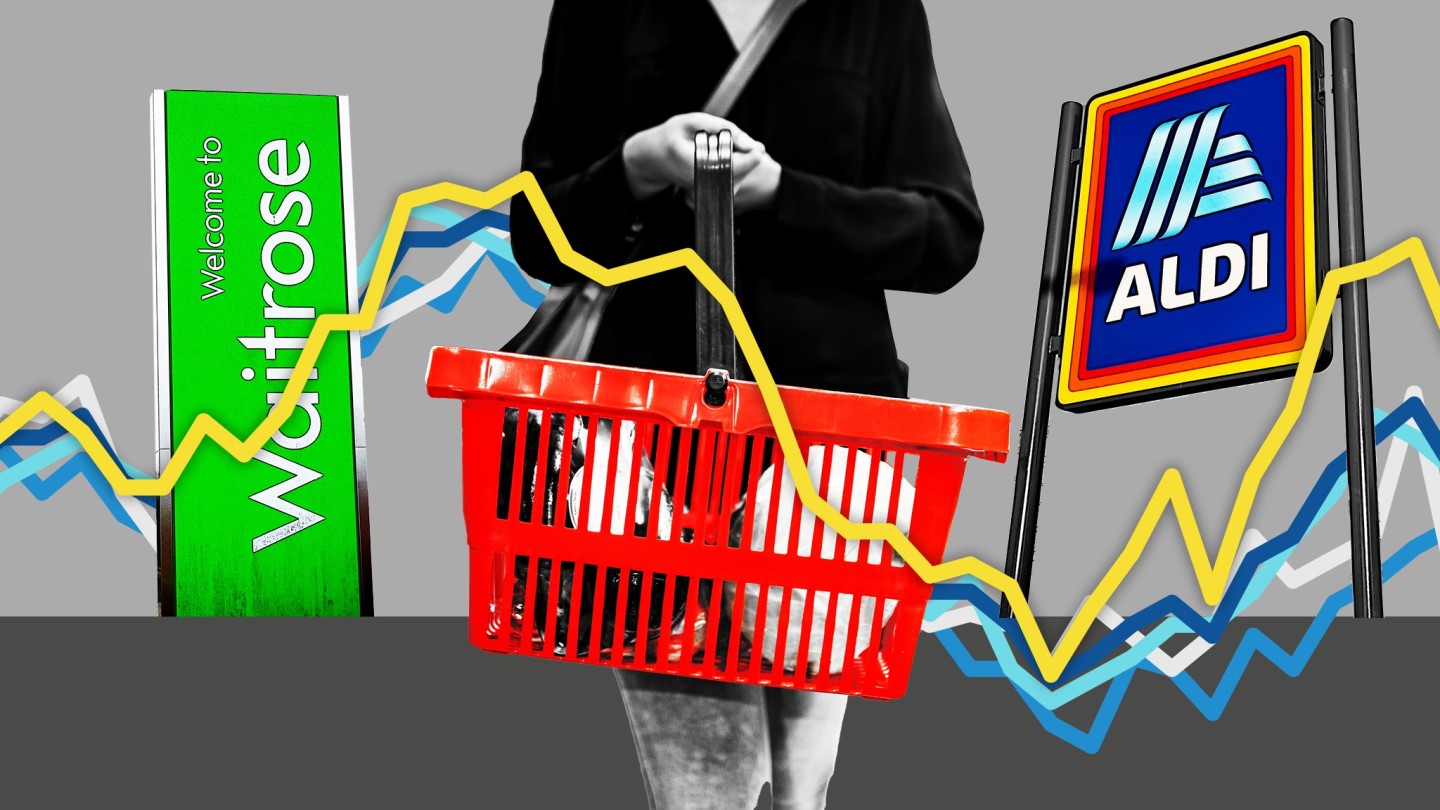
Simply sign up to the Cost of living crisis myFT Digest -- delivered directly to your inbox.
Alan Plampton, a retired accountant from Cromarty in Scotland, has been monitoring rising food prices more closely over the past year.
But he refuses to skimp. “We want to have a quality product where possible at the best value,” says the 70-year-old, who lives with his wife. “But . . . there’s no point in paying a cheaper price if it’s rubbish or it doesn’t last as long.”
For Joe and Hannah, who are 30 years younger, the impact of the UK’s cost of living crisis is more acute even though they, like Plampton, describe themselves as middle class.
“I feel like the elasticity that we have with shopping has reached the maximum point,” says Joe, who is a transport planner in London. “I think we’ve cut back on everything we could.”
Impromptu trips to Tesco Express convenience stores to buy ingredients for a single meal, or to more upmarket Waitrose for a small shop are no longer the norm, adds Hannah, a teacher. “We’ve absolutely become more price sensitive and price conscious,” says Joe. The couple, who have a four-year-old son, asked the Financial Times not to use their surname.
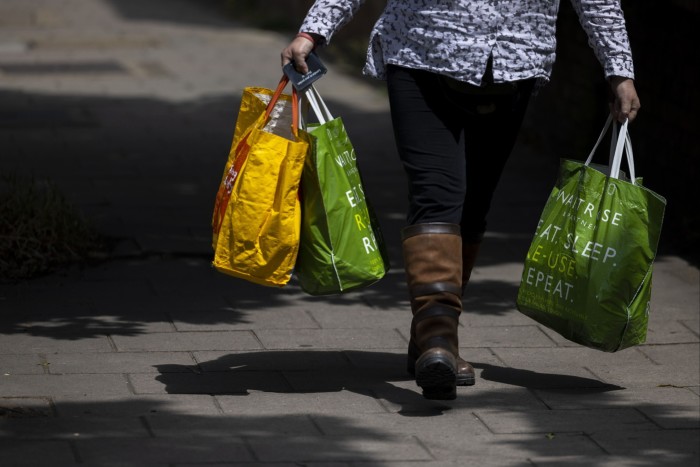
A long squeeze on incomes in the UK has intensified since the pandemic and Russia’s invasion of Ukraine pushed up the price of many goods. It is changing how Britain’s middle-class consumers, whose power and influence grew in the second half of the 20th century as wages, home ownership and access to credit all expanded, view their financial situations.
The squeeze is about to get more acute after the Bank of England raised interest rates 14 times in 21 months to try to get inflation under control, sending mortgage rates to their highest levels since February 2008. The size and speed of the increases are causing angst in the 1.4mn British households expected to roll off fixed-rate mortgage deals this year alone, and exacerbating a split between older and younger consumers in similar socio-economic brackets.
“Suddenly those middle-class households that were otherwise protected, or at least more protected from price rises, are now in a situation where their main expenditure item is about to rocket,” says Rich Shepherd, a senior analyst at market research group Mintel.
Food and apparel retailers, restaurants and airlines could soon find that the financial wriggle room of some better-off consumers is shrinking as they prioritise financial resilience over spending. A key question for such companies will be whether these changes are a temporary response to new circumstances, or a more permanent shift in consumer behaviour.
“Brands just need to understand the mechanics of where finances are and how that has impacted [consumers’] mindset,” adds Shepherd. “Mindset is really the key thing.”
The long expansion
In the late 1950s, the National Readership Survey devised a socio-economic grading system based on the occupation of the chief earner to segment households.
In that system, “middle class” is generally defined as A and B consumers — people in higher and intermediate managerial roles in administrative and professional occupations. The NRS system is still widely used, although income — the UK median disposable household income in 2022 was just under £33,000 — is also used as a proxy.
After two decades during which incomes grew, home ownership rose and access to credit widened, by the early 2000s it was routine for households to have credit from multiple lenders, amplifying their spending power.
The growth of Asian manufacturing meant the prices of many goods fell in real terms. Households spent proportionately less on essentials and had more money to devote to indulgences. The combination of rising financial firepower, more choice and more affordable products meant retail sales grew steadily for years.
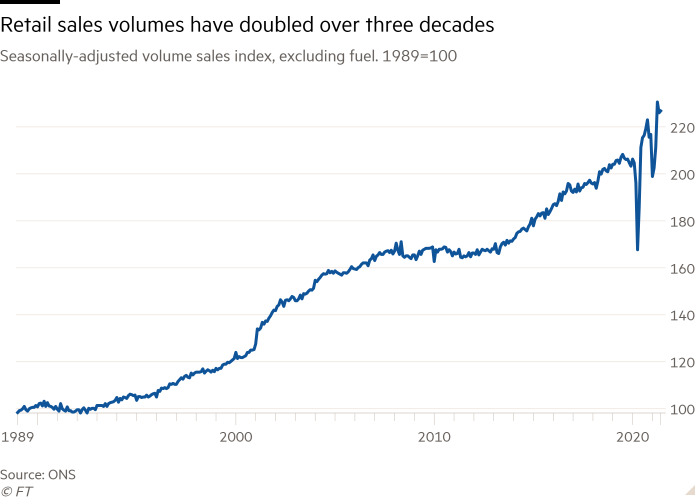
Retailers with an established high street presence, such as Next, Marks and Spencer and John Lewis, responded by opening more stores, cementing their dominance.
But the onset of the global financial crisis of 2008/9, when a year-long recession was followed by a long period of very low interest rates and anaemic wage growth, helped drive a sea change in consumer behaviour.
“What the recession brought was the acceptance of Primark, Aldi, Lidl, B&M, and [the idea of] shopping across ranges,” says Lisa Hooker, leader of industry for consumer at PwC. Previously, she adds, a lot of the value end of the market “was seen as a compromise on quality and I think over the years, coupled with the recession, the value-end improved their quality”.
Nowhere was this more obvious than at the two German discounters Aldi and Lidl. Their first UK stores had opened in the 1990s, selling around 800 basic products from spartan stores at a fraction of the price of traditional supermarkets. By the time the crisis struck, they had inched up to a combined 5 per cent market share.
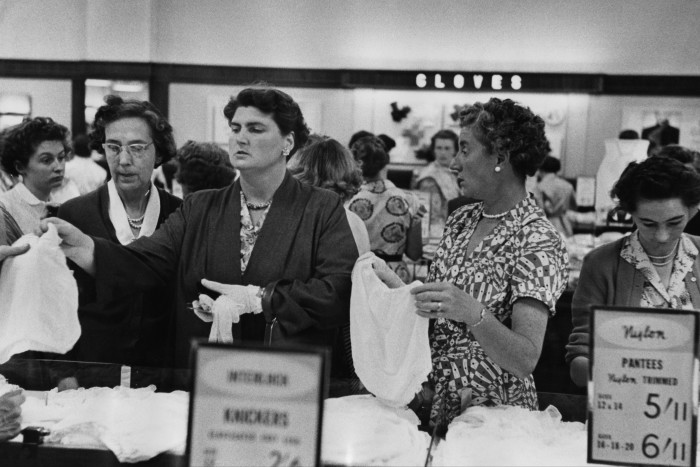
But a so-called claret offensive involving the introduction of top-of-the-range wines, lobsters for £5, luxury ranges and British produce put them on the radar of more discerning buyers. They responded by opening hundreds more stores, often in smarter locations.
“The real revelation for Aldi and Lidl was a change in their real estate strategy, which started around the 2000s,” says one former supermarket executive. “They recognised that they needed to be in good retail locations with car parks. There was a natural shift to presenting themselves to a more middle-class customer by virtue of their location strategy.”
The years after the financial crisis also saw the rise of the smartphone, which helped turbocharge online shopping and brought new competition for middle-class spending.
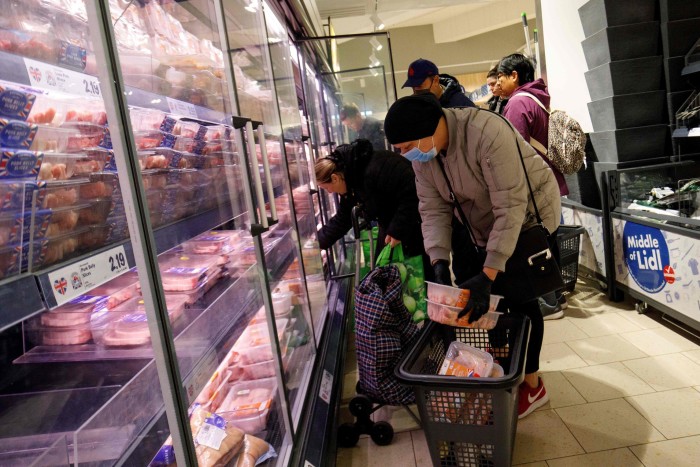
The result was a new era of savvier shopping during which customer loyalty went out of the window. James Bailey, executive director at Waitrose, points out that the number of retail brands that shoppers buy from in a month “has been gradually creeping up” for more than a decade. “Before that, most people would spend most of their money doing one big shop.”
As a result of that change, along with the proliferation of alternative sales channels, he says “there isn’t really such a thing as ‘a Waitrose shopper’ — it’s a surprising spread of customers, with a slight bias towards more affluent, older customers”.
That reflects wider divisions within the consumer group. “You’ve got quite an interesting split, not just in terms of socio-economic groups but also age groups,” says Philip Shaw, chief economist at Investec, who adds that well-off retirees represent “quite a more potent consumer group”.
They and the highest earners have the healthiest finances while younger people still living at home have more disposable incomes, said PwC in a recent survey.
The middle-aged consumer, typically between 35 to 54, often with children and mortgages, remains under the greatest financial pressure.
The years that followed the financial crash were also defined by a move from buying things to doing things, prompting one executive at Swedish furniture retailer Ikea to proclaim the world had “hit peak stuff”.
Low-cost airlines expanded their networks and restaurant chains, fuelled by private equity investment and cheap borrowing, opened hundreds of new outlets.
The Covid-19 lockdowns that started in 2020 and continued intermittently through 2021, brought the experience economy to a halt and boosted retailers such as Currys and DIY chain B&Q, as people stuck at home splashed the cash on gadgets and home renovations.
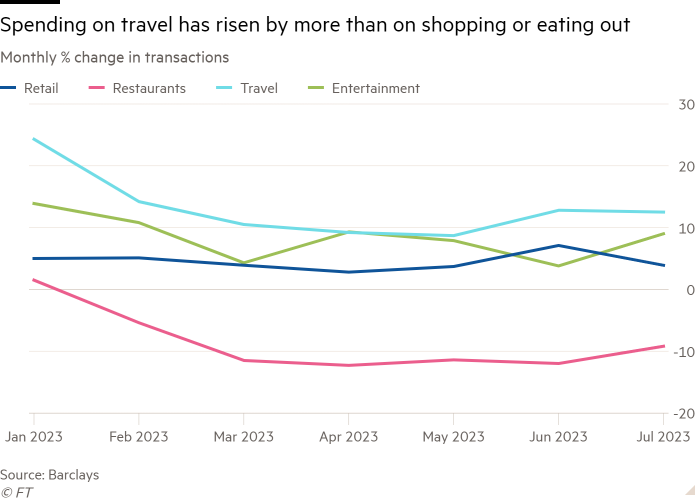
But the long-term trend appears to be reasserting itself in the aftermath of the pandemic, despite surging prices for everything from package holidays to festival tickets and the uncertainty about mortgage rates.
Shepherd says this is because middle-class consumers who are used to spending more on themselves and more on experiences “still want and need those everyday indulgences” even when times are tight. “It can’t just be doom and gloom.”
Monthly figures from Barclays, which processes about half of Britain’s credit and debit card transactions, have shown consistent growth in spending on entertainment and travel, with airlines and travel agents particular beneficiaries.
When the party ends
Shaw at Investec believes government financial support helped support household finances. The Covid-era furlough scheme blunted the impact of lockdowns on incomes and unemployment, while the lengthy closures of non-essential retail and hospitality restricted spending, leading to a pile-up of savings that are now being run down.
“No one knows how big that pile is . . . but our estimates suggest it might have been up to about £180bn at the peak and we now think that more than halved to around £75bn,” he says. “It’s extremely likely that it’s better-off households that have bigger cash piles even proportionately to income.”
State relief from sharply rising energy costs has also helped. But there will be much less protection from rising mortgage rates. “I do think we are going to see headwinds intensify and the intensity of cutbacks will be focused more on middle and high-income households because of what’s happening with mortgage rates,” says Richard Lim, chief executive of Retail Economics.
Survey evidence already points to this. Roughly two-thirds of middle-class households are finding it harder to save and would prioritise putting money aside if their financial situation improved significantly, according to Mintel.
“This cautiousness is perhaps something that you would expect to see lower down the income scales, lower down the socio-economic scales,” says Shepherd.
Joe, one half of the London couple, says “we’re going to have to look at utilities and mortgage payments again” if inflation does not ease. “It would be another chapter and I would hope we don’t have to get to that point.”
The proportion of more affluent shoppers saying they had moved to cheaper options at supermarkets has risen from 28 per cent in April 2022 to 40 per cent a year later, according to the Institute of Grocery Distribution. Those who said they were prepared to eat perceived lower quality food has risen from 16 per cent to 23 per cent.
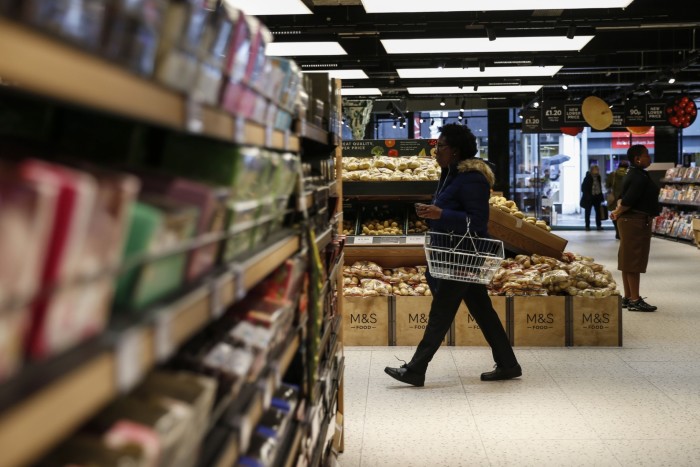
Supermarkets report more interest in their premium ready meal ranges as consumers think twice about eating out — spending in restaurants has fallen for the past five months in a row, according to Barclays data.
“I’m not prepared to go to PizzaExpress and spend £100 on a meal, when I can go to M&S and buy a pizza deal for £12 with two sides and a nice bottle of wine,” says Catherine Shuttleworth, who runs digital marketing agency Savvy. Its research found that AB consumers were also ordering fewer takeaway meals, searching out coupons and vouchers and doing more cooking from scratch in response to budget pressure.
Demand for some big-ticket retail items has started to soften; sofa retailer DFS warned last month that the market has been “significantly worse than expected”, while the boss of bike and car parts seller Halfords said in an interview that customers were spending more time “thinking carefully about big ticket discretionary spend”.
But Lim points out that a hard core of determined spenders remains. “What we’re seeing is a polarisation in the market. There’s about 15 per cent of consumers that say that they are undeterred in their spending. These are consumers that are basically ‘keep calm, carry on; the cost of living crisis doesn’t really impact me’.”
They may live in one of almost a third of UK homes that are now owned outright, they may be protected from rising rates by a fixed-rate mortgage for a few years to come, or they may have benefited from wage growth that hit a record high of 7.3 per cent this year and has been skewed towards higher earners.
“They are the most affluent consumers and they spend disproportionately,” adds Lim, pointing out that the top 20 per cent of UK householders are responsible for 40 per cent of consumer spending.
Such resilience is why the middle-class consumer still matters so much to retailers, restaurateurs and hoteliers alike. His or her spending power extends beyond basic needs, and factors such as quality or provenance can rank higher than price when purchasing goods.
“The supermarkets are going to be fighting to keep their middle-class shoppers on the basis that when things get better again, they are the ones that will trade up and will spend more,” says Shuttleworth.
Retailers had been deploying various tactics to hold on to fickle middle-class shoppers even before the cost of living crisis, from revamped loyalty schemes and price-matching campaigns to new lower-cost ranges.
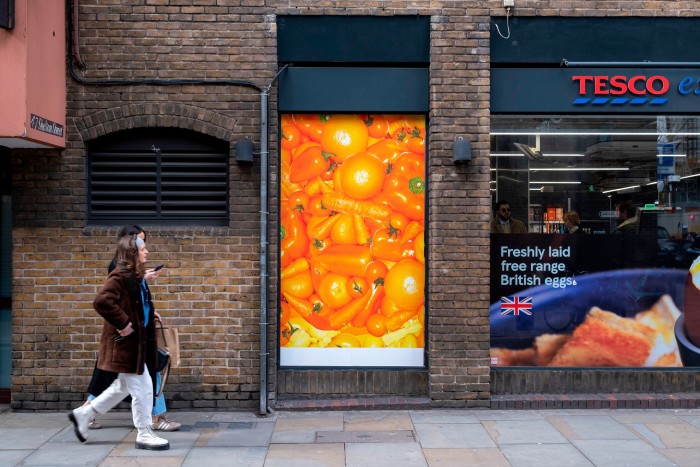
Ocado, the online supermarket known for selling Navarrico jarred chickpeas and rose harissa paste to middle England, has refined its marketing efforts to retain existing shoppers and attract new ones. Chief executive Tim Steiner said last month he does not want “the wrong customers” who respond to promotions but cannot be converted into regular shoppers. “You throw a bigger voucher at it, you acquire 20,000 customers that week, but the problem is, they don’t stick with you,” he says.
The quid pro quo is that middle-class consumers are demanding. Manfred Abraham, chief executive of Yonder Consulting, says they expect companies to stick to their values irrespective of what is happening to their own operating costs. Cutting back on sustainability or customer service is likely to put them off.
Bailey agrees, saying that while value has become more important “for obvious reasons”, Waitrose customers still care most about quality, service and ethics. “[They] don’t want cheaper cuts of meat that come from abroad. They want British beef, they want the sourcing and credentials we give them, but for certain meal occasions they do want us to offer them an alternative to eating out and they do want the option to put ‘essentials’ mince in a bolognese,” he adds, referring to the firm’s entry-level product range.
Even while many consumers focus on finding the lowest prices, brands will have to continue innovating in anticipation of better times ahead, says Shepherd at Mintel. He points out that previous downturns have included “a period where people have to bunker down a little bit and focus on functionality and price”.
“But when they get out of that period they want to get out, get new products and try new things.”
Comments